Abraliopsis falco
Richard E. Young and Kotaro TsuchiyaIntroduction
A. falco is a rather large member of the subgenus Pfefferiteuthis, reaching a length of at least 46 mm ML. It is very similar to Abraliopsis sp. A and Abraliopsis sp. P from the tropical Pacific and A. atlantica from the Atlantic Ocean.
Brief diagnosis:
An Abraliopsis (Pfefferiteuthis) ...
- without keel or carpal flap on tentacular club.
- with small size difference (about 2x) between largest ventral club hook and its dorsal counterpart.
- with central bare strip of Median Mantle Sector that can be difficult to detect.
Characteristics
In addition to familial characters (listed on the Enoploteuthidae page) and generic characters (listed on the Abraliopsis page), Abraliopsis falco has:- Arms
- Arms IV relatively long; ALI-ALIV = 55-79; formula - 4=2>3>1.
- Arms of males longer and hooks smaller than in females.
- Arms I-III with 16-23 hooks (females), and 24-34 (males).
- First basal hook, arms III, ventral series much larger than second basal hook of same series and about equal or larger in size to counterpart in dorsal series. Basal hooks 2-4 of arms III, dorsal series much larger than counterparts of ventral series.
- Arms IV with 21-26 hooks (females) and 39-45 (males, left) or 26-32 (males, right = hectocotylus).
- Hectocotylus with two subequal-sized offset flaps.
- Proximal modified portion of hectocotylus with armature.
- Protective membrane and its spatulate trabeculae well developed on left arm IV, web-like; with minute conical papillae on trabeculae.
- Arms IV of males with hooks of varying sizes depending on margin and position along arm.
- Largest suckers of distal arm with 10-12 rounded to truncate teeth on distal margin of inner ring.
- Males with proximal hook of ventral margin greatly enlarged over succeeding hook of series (see arrow in image below).
- Tentacle clubs
- Large ventral hooks of manus about 2x height of dorsal counterparts; ventral series with 3-4 hooks, dorsal series with 2-4 hooks.
- Carpal flap absent; keel absent.
 Click on an image to view larger version & data in a new window
Click on an image to view larger version & data in a new window

Figure. Tentacular club of Oral view of A. falco. Left - 40 mm ML, off Southern California. Drawing modified from Young (1972). Right - Ventral (left), oral (middle) and aboral (right) views, paratype, male, 39 mm ML, off Baja California. Photographs by R. Young.
- Large ventral hooks of manus about 2x height of dorsal counterparts; ventral series with 3-4 hooks, dorsal series with 2-4 hooks.
- Photophores
- Ocular photophores: 5 photophores, terminal members "considerably" larger than middle 3.
- Integumental photophores: 3 series on ventral head, 6 on ventral mantle.
 Click on an image to view larger version & data in a new window
Click on an image to view larger version & data in a new window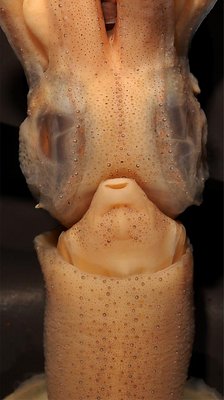
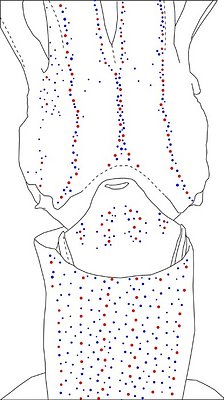
Figure. Ventral views of the integumental photophores of A. falco, holotype, mature male, 37 mm ML, off Baja California. Left - Photograph of the preserved squid. Right - Outline drawing from previous photograph with all integumental photophores represented by colored dots. Red dots - Comples photophores. Blue dots - Non-complex photophores. Images by R. Young.
Detailed information on the integumental photophores can be found here.
- Viscera
- Spermatangia receptacles: A large female (see photograph below) had spermatangia in the stellate pocket (pocket between stellate ganglia) but none in the dorsal-collar pocket which lacked pigmentation but showed many folds.
- Spermatangia receptacles: A large female (see photograph below) had spermatangia in the stellate pocket (pocket between stellate ganglia) but none in the dorsal-collar pocket which lacked pigmentation but showed many folds.
- Table of measurements and counts
Comments
Comparisons of all species in the subgenus can be found on the Abraliopsis (Pfefferiteuthis) page.
Distribution
Geographical Distribution
Type locality: Eastern North Pacific at 28°54'N, 118°08'W. The type series (9 squid) all came within a degree (latitude and longitude) of this locality. Considering the similarity with other species of the subgenus now known to exist, other literature records must be suspect for the present.
References
Okutani, T. 1974. Epipelagic decapod cephalopods collected by midwater tows during the EASTROPAC Expedition, 1967-1968 (systematic part). Bull. Tokai Reg. Fish. Res. Lab., 80:29-118.
Young, R.E. 1972. The systematics and areal distribution of pelagic cephalopods from the sea off southern California. Smiths. Contr. Zool., 97:1-159.
Title Illustrations

| Scientific Name | Abraliopsis falco |
|---|---|
| Location | Off Southern California |
| Reference | Young, R.E. 1972. The systematics and areal distribution of pelagic cephalopods from the sea off southern California. Smiths. Contr. Zool., 97:1-159. |
| Sex | Male |
| View | Ventral |
| Size | 37 mm ML |
| Scientific Name | Abraliopsis falco |
|---|---|
| Location | Eastern tropical Pacific off Baja California at 28°54'N, 118°08'W |
| Specimen Condition | Preserved |
| Sex | Male |
| Life Cycle Stage | Mature |
| View | Ventral |
| Size | 37 mm ML |
| Collection | SBMNH 34957 |
| Type | Holotype |
| Image Use |
 This media file is licensed under the Creative Commons Attribution License - Version 3.0. This media file is licensed under the Creative Commons Attribution License - Version 3.0.
|
| Copyright |
©

|
About This Page

University of Hawaii, Honolulu, HI, USA

Tokyo University of Fisheries, Tokyo, Japan
Page copyright © 2013 and
 Page: Tree of Life
Abraliopsis falco .
Authored by
Richard E. Young and Kotaro Tsuchiya.
The TEXT of this page is licensed under the
Creative Commons Attribution-NonCommercial License - Version 3.0. Note that images and other media
featured on this page are each governed by their own license, and they may or may not be available
for reuse. Click on an image or a media link to access the media data window, which provides the
relevant licensing information. For the general terms and conditions of ToL material reuse and
redistribution, please see the Tree of Life Copyright
Policies.
Page: Tree of Life
Abraliopsis falco .
Authored by
Richard E. Young and Kotaro Tsuchiya.
The TEXT of this page is licensed under the
Creative Commons Attribution-NonCommercial License - Version 3.0. Note that images and other media
featured on this page are each governed by their own license, and they may or may not be available
for reuse. Click on an image or a media link to access the media data window, which provides the
relevant licensing information. For the general terms and conditions of ToL material reuse and
redistribution, please see the Tree of Life Copyright
Policies.
- Content changed 03 November 2013
Citing this page:
Young, Richard E. and Kotaro Tsuchiya. 2013. Abraliopsis falco . Version 03 November 2013 (under construction). http://tolweb.org/Abraliopsis_falco/19685/2013.11.03 in The Tree of Life Web Project, http://tolweb.org/





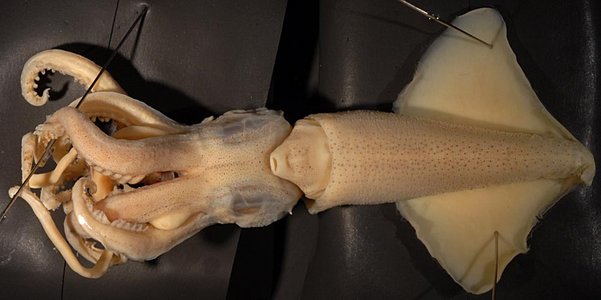
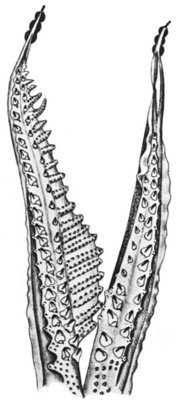
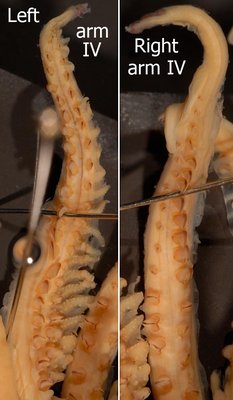
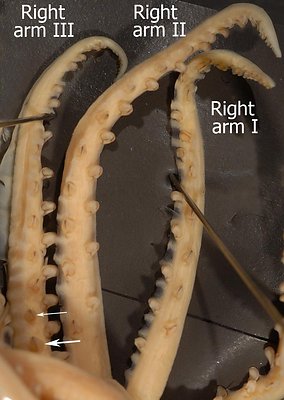
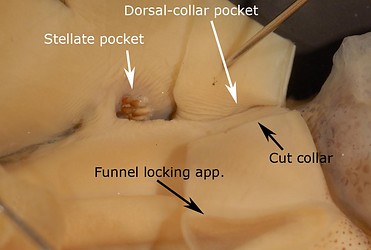
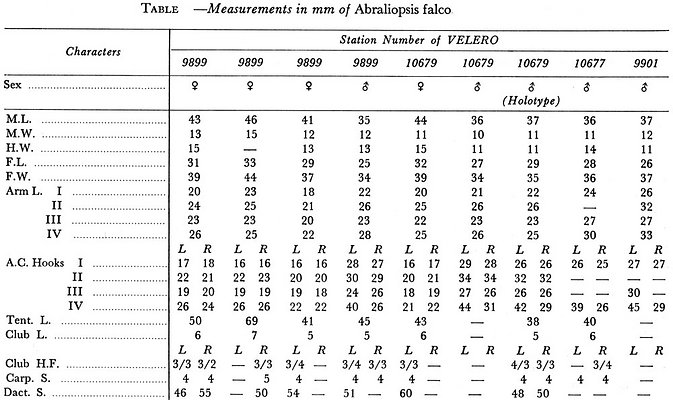
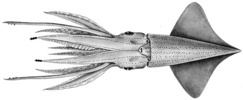
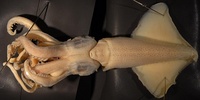


 Go to quick links
Go to quick search
Go to navigation for this section of the ToL site
Go to detailed links for the ToL site
Go to quick links
Go to quick search
Go to navigation for this section of the ToL site
Go to detailed links for the ToL site